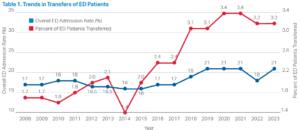
Transferring patients from one ED to another hospital is an established part of emergency medicine practice. Patients who need inpatient services do not match the index hospitals’ capabilities, or the patient requests such a transfer, or the hospital has no available inpatient space. The rate of transfers was stable for many years, typically around 2 percent.
Explore This Issue
ACEP Now: Vol 43 – No 06 – June 2024Transfers have always been an area of concern to hospital administrators and emergency physicians. In 1986, Congress enacted the Emergency Medical Treatment and Labor Act (EMTALA) to ensure public access to emergency services regardless of ability to pay. Section 1867 of the Social Security Act imposes specific obligations on Medicare-participating hospitals that offer emergency services to provide a medical screening examination (MSE) when a request is made for examination or treatment for an emergency medical condition (EMC), including active labor, regardless of an individual’s ability to pay. Participating hospitals are then required to provide stabilizing treatment for patients with EMCs. If a hospital is unable to stabilize a patient within its capability, or if the patient requests, an appropriate transfer should be implemented. This law, along with many court rulings since its enactment, makes all patient transfers an area of review and concern.
Two years ago, an ACEP Now article covered the issue of transfer challenges resulting from early pandemic operations.1 As fresh challenges of the pandemic and hospital operations changed emergency medicine practice, one of the more challenging areas was the movement of admitted patients out of the first emergency department (ED). Many EDs have been unable to move admitted patients into appropriate inpatient beds in any hospital, and the result has been inpatients stacked in hallway beds in the ED.
A recent study from JAMA Network Open highlighted the issues of patient transfers, particularly for small rural hospitals.2 Their study was limited to 681 hospitals and characterized transfer patterns related to caseload-constrained hospitals. They reported concerns related to overcoming barriers to transferring patients in future surges.
In fact, that study underestimated the ongoing challenges affecting patient transfers in U.S. emergency departments. Transfer rates are up across all types of EDs. In the last couple of years, EDs have transferred 3.2 percent of patients—twice the rate in 2010 (Table 1).
The data additionally show the ongoing transfer rate is higher in small volume EDs (4.7 percent). ED transfer rates vary dramatically by cohorts, increasing by nearly a factor of three for hospital-based EDs with decreasing volume (Table 2).
Pages: 1 2 3 | Single Page





No Responses to “Interhospital Transfer Capabilities Still Pose Major Issues”